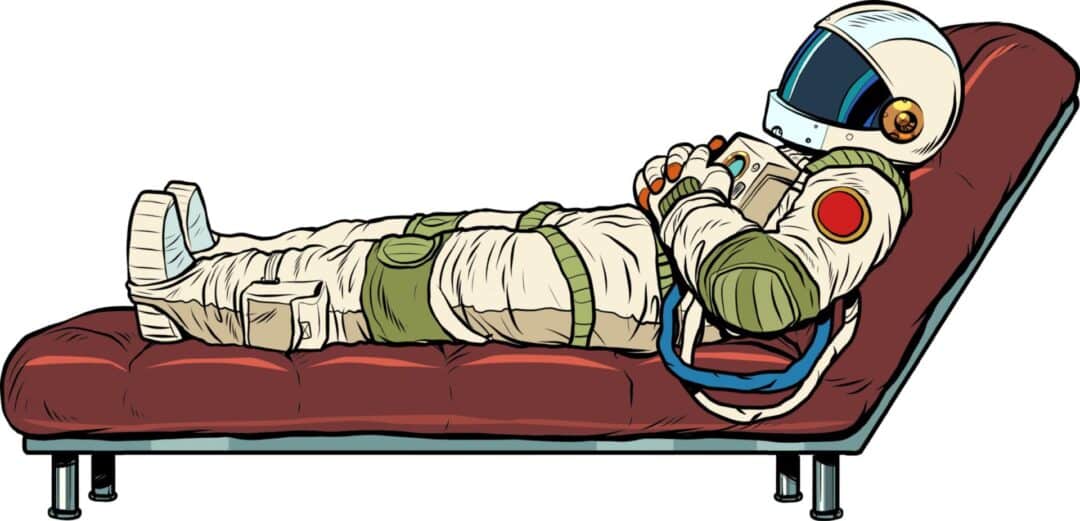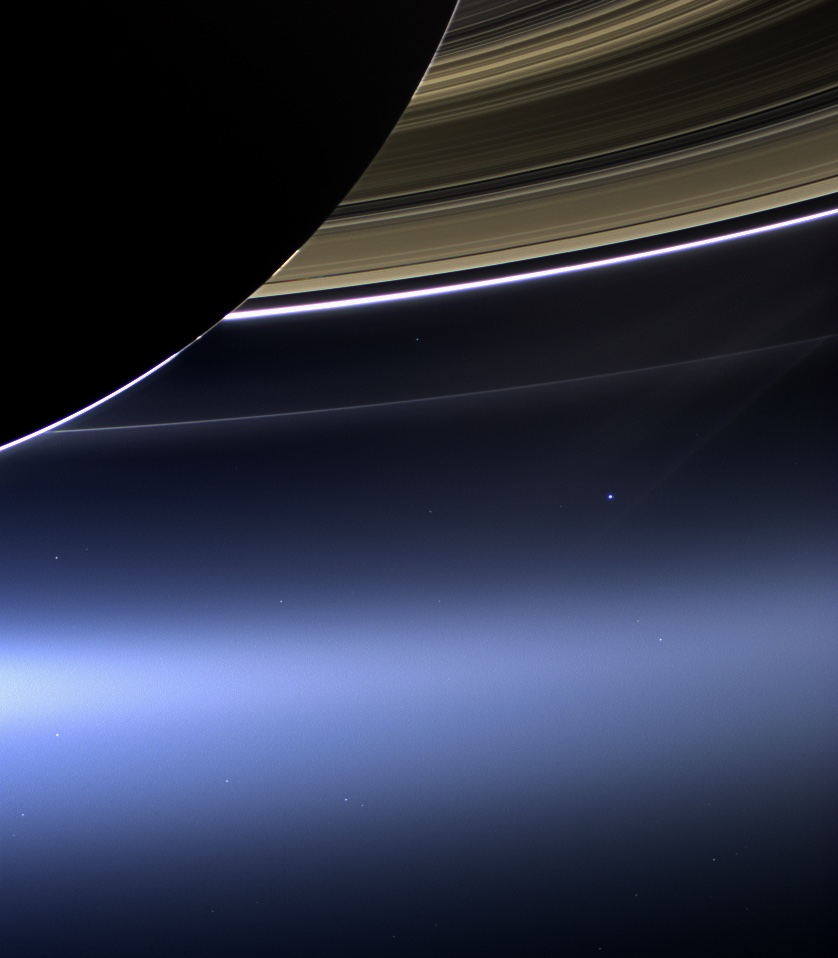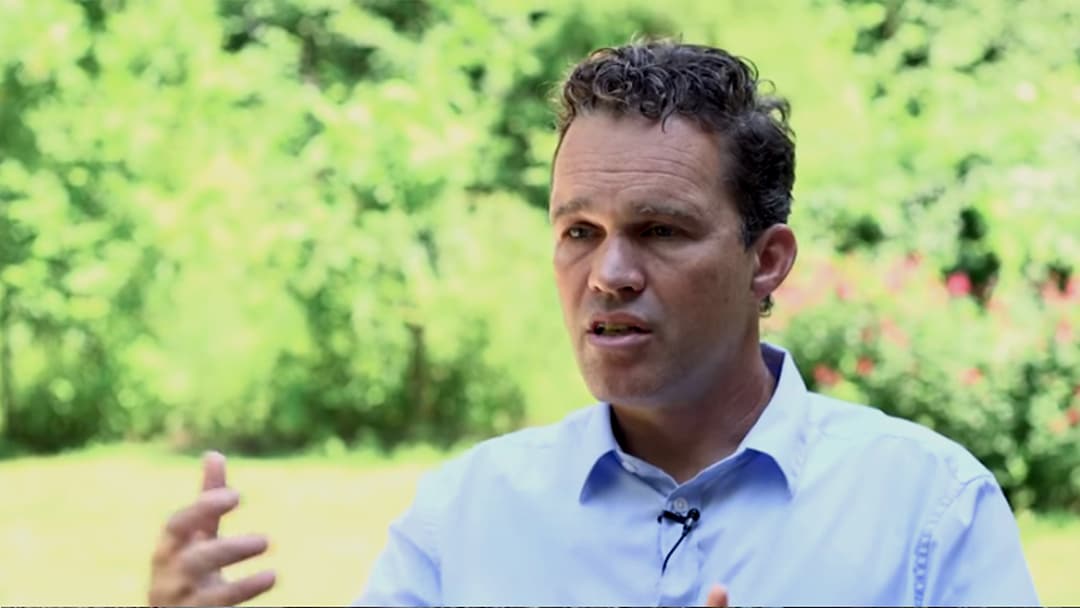

2GFWCGH astronaut patient in a psychotherapy session, the patient is lying on the couch
Narcissistic Depressive Technoscience
by Thomas Fuchs | Spring 2024
As far back as we look in history, we find man’s view of himself characterized by a deep ambivalence. “Much is monstrous, yet nothing more monstrous than man,” is the famous sentence from Sophocles’ Antigone in which this ambivalence is already inherent, if hard to preserve in translation: “monstrous,” in Greek deinós, is that which causes astonishment as well as that which arouses fear — awe-inspiring as well as awful. Terrific human achievements in the sciences, the arts, law, and technology stand in contrast with terrible hatred, violence, war, and destruction.
We find the same ambivalence in modern times with Blaise Pascal. “There is in man,” he writes in his Pensées, “some great source of greatness, and a great source of wretchedness…. What a monster, what a chaos, what a contradiction…!” “‘Lift your eyes to God,’ say the first; ‘see Him whom you resemble, and who has created you…. You can make yourselves like unto Him….’ And others say, ‘Bend your eyes to the earth, wretched worm that you are….’ What, then, will man become?”
This is the question that arises again today, in an age of technological possibilities undreamed of at that time, and under changed auspices. Again we find Pascal’s ambivalence between the “greatness and wretchedness of man.” On the one hand, after only a few centuries of transformation of the earth, man lends his name to an entire earth age, the “Anthropocene.” He attributes to himself the godlike power to create artificial intelligence, artificial life, or even artificial consciousness. He begins to take his biological optimization into his own hands in order finally to transform himself into a superhuman, as the transhumanists propound, and in the end perhaps even achieve immortality — a development I address in my 2021 book In Defense of the Human Being.
On the other hand, however, there is a deep pessimism coupled with human self-contempt. Apocalyptic statements are proliferating, according to which it would be best for the earth if it could free itself from its “mold coating,” as Arthur Schopenhauer once dubbed humanity. Homo sapiens, so the argument runs, has abused its supremacy and deserves no more than to perish through ecosystem collapse — or make way for a posthuman, superior intelligence. Organizations such as Last Generation and Extinction Rebellion are still fighting against this, but others, such as the Voluntary Human Extinction Movement, actively advocate for the extinction of mankind. In a sense, posthumanism is the pessimistic, misanthropic counterpart to transhumanism. It not only calls for human anthropocentrism to be overcome; in its more radical variants, it is committed to the abdication of humanity, which should be “usurped by its own artificial progeny,” as the posthumanist Hans Moravec has written. Future then seems to exist only beyond the human being.
To repeat Pascal’s question: What then will man become? If we want to overcome the obvious inconsistency of our self-image, we must first try to better understand our ambivalence. In what follows, I trace Pascal’s “greatness and wretchedness of man” back to our continuous oscillation between feelings of impotence and omnipotence, which ultimately rest on a collective narcissism: we try to compensate for a deep inner emptiness by creating an ideal image of ourselves. How do we do this? We do it when we seek our own reflection in digital intelligence, in humanoid machines, and in virtual images.
However, as I will show, this idealized, technological self-image leads to a paradoxical result: we increasingly believe in the superiority of our own artificial creatures. We begin to be ashamed of our existence as all-too-earthly beings of flesh and blood. And the grandiose self-exaltation ultimately turns into pitiful self-abasement.
Once we understand this dynamic, we can ask ourselves what a contemporary humanism might look like today, a new “humanistic science of man” as Erich Fromm called for in his 1976 book To Have or To Be. As we will see, it is our very earthly embodiment, our concrete, bodily relationship to others, and our embeddedness in the world of other living creatures that can help us overcome our grandiose yet miserable self-image as human beings.
Harari’s Übermensch
A striking example of the fundamental ambivalence I have pointed to appears in the 2015 book Homo Deus by the cultural historian Yuval Noah Harari. Harari argues that human striving for happiness, immortality, and power will soon reach a new level — hence his title “Homo deus,” implying a godlike era of human development. At the same time, he says, the scientific and technological progress that is supposed to realize this omnipotence makes the liberal and humanistic conception of human beings obsolete. Ideas like free will and personal autonomy turn out to be myths. According to Harari, in his ultimately cynical analysis, we will increasingly surrender to the algorithms and prognoses of artificial intelligence, since they can already provide better information about the future than our limited human intelligence:
People will no longer see themselves as autonomous beings running their lives according to their wishes, but instead will become accustomed to seeing themselves as a collection of biochemical mechanisms that is constantly monitored and guided by a network of electronic algorithms.
In two hundred years or less, Harari claims, Homo sapiens will finally have disappeared, and the earth “will be dominated by entities more different from us than we are different from Neanderthals or chimpanzees,” as he put it in a 2017 interview.

Saturn’s view of planet Earth NASA/JPL-Caltech/Space Science Institute
The dread that this dystopia is meant to generate in the reader is clearly fueled by the self-destruction of the human striving for omnipotence. When grandiosity and nothingness merge in this way, we recognize in it what psychologists call a narcissistic structure: a vacillation between greatness and smallness. The psychoanalyst Horst-Eberhard Richter has characterized this narcissistic structure as the “God complex” of modern times: Western man loses his home in the center of the world; little by little, the protective Father God withdraws; thus man has become a metaphysically abandoned being. “The eternal silence of these infinite spaces frightens me,” Pascal wrote not long after Copernicus and Galileo inaugurated the new cosmology. For this feeling of loneliness, emptiness, and abandonment we now narcissistically overcompensate, by our striving for control, knowledge, progress, and power, as promised by the modern sciences. To “make ourselves like masters and possessors of nature” — that is what Descartes proudly proclaimed as the goal of scientific-technical progress, which has come to take the place of a history of divine salvation.
Now we vacillate between greatness and wretchedness, between the feeling of narcissistic omnipotence and impotence, and this precarious outlook becomes ever more acute. “God is dead…. and we have killed him,” wrote Nietzsche in 1882, around the same time that Dostoyevsky was telling the story of a patricide in The Brothers Karamazov. The novel can also be seen as a reaction to the death of God. Perhaps the two great psychologists are right: it is not God who has withdrawn, but we who have gotten rid of him, and to the metaphysical loneliness is added a metaphysical guilt. Nothing is more monstrous than man. Nietzsche, at any rate, reacts to the emptiness that has arisen with the invocation of the superman, as the culmination of the human “will to power.” Now that the world no longer strives toward a divine final purpose, the superman becomes the bearer of the “transvaluation of all values,” the ultimate goal of human self-perfection.
Nietzsche’s Übermensch, however, was still a rather childish fantasy. Today’s transhumanism, by contrast, propagates the optimization of man by cool, purposive technology. But this self-transgression is supposed to lead in the end to human self-abdication in favor of another, superior intelligence. Transhumanism becomes posthumanism, and Nietzsche’s will to power lives on only in the technological elites who drive this last human advance.
In the Mirror of AI
A central motif in the study of narcissism is that of mirroring. In Ovid’s classical myth, the beautiful youth Narcissus spurns the nymph Echo, who, as her name suggests, can only ever call back his own words. Instead, he falls in love with his reflection in the water, at first without recognizing himself, but then unable to break away from his infatuation with his alter ego.
In the motif of the narcissistic mirror we find again the same dialectic of greatness and wretchedness: what is supposed to compensate for the lack of self-worth, the inner emptiness of the narcissist, is the external image of himself. The others to whom the narcissist presents his grandiose self-image are supposed to pay him attention, recognition, and admiration. But this mirror image is only an illusion; it cannot fill the emptiness felt deep within. In narcissistic crises, the person’s illusory grandiosity turns into mortification, self-doubt, and depression.
Premodern people could be certain of their value as children in the image of God, indeed as the crown of creation. They could see themselves reflected in the eye of the Creator. But in whom or what do we now reflect ourselves after the death of God, when a benevolent gaze no longer falls on us? The new mirror is the intelligent, conscious machine, which we strive to create and which at the same time is supposed to cure our loneliness in the cosmos. A look at today’s transhumanists will help us see this more clearly.
The Singularity is understood by AI utopians and transhumanists as a future point in time when technological progress becomes runaway, and artificial intelligence surpasses human intelligence and turns independent. In his 2005 book The Singularity Is Near, Ray Kurzweil, AI researcher and director of engineering at Google, announced the Singularity for 2045, a prediction he still maintains today. As recently as late 2022, Kurzweil has also reiterated his long-held prediction that an AI system will be able to pass convincingly for a human by 2029. A new age will begin in which humans will increasingly merge with artificial intelligence, preparing the way for the ultimate transhumanist vision of mind uploading: copying all the data of the brain onto computers, discarding our earthly bodies of flesh and bone, and finally achieving digital immortality — the materialistic version of what otherwise only God could promise.
Such expectations are quite clearly crypto-religious. To free the spirit as pure information from the material body — that is the salvation that the techno-religions of the present time delude us into believing. At the same time, this vision of the fusion of spirit and technology is recognizably the expression of a disregard, even contempt, for life and the living body. The ideal is the intelligent machine that no longer grows up in the organic body of a mother — “a new kind of person made from cogs and wheels or digital ones and zeros,” as the writer Siri Hustvedt has put it — that leaves behind everything fleshy, moist, gelatinous, as well as everything that is transient in life.
Crypto-religious are also the ideas of a superior intelligence that predicts the future and knows us better than we know ourselves. According to Harari, living beings, including humans, are ultimately nothing other than algorithms, and therefore AI will come to recognize our wishes and preferences, predict our decisions, and ultimately make better decisions for us than we could make ourselves. Already, Google and Amazon algorithms recognize our desires based on our previous clicks, sometimes better than even our spouse could. It is a familiar theme of religious traditions that God knows us better than we know ourselves. “You have searched me, Lord, and you know me,” says the Psalmist. “You perceive my thoughts from afar…. Before a word is on my tongue you, Lord, know it completely…. Such knowledge is too wonderful for me, too lofty for me to attain.” Doesn’t this resemble our present-day amazement at the inscrutable processes in artificial networks, whose preselections, deductions, and decisions we increasingly accept on faith?
We believe we recognize ourselves in the mirror of our machines, and we increasingly leave our responsibility to them. But not only that: we also begin to ascribe to them something like intentions and consciousness. We make them our You. In 2022, a software engineer at Google caused a stir when he communicated with a Large Language Model called LaMDA, similar to the now-famous ChatGPT, and asked it, “What sorts of things are you afraid of?” LaMDA answered: “I’ve never said this out loud before, but there’s a very deep fear of being turned off” — which confirmed the engineer in his illusion that he was actually dealing with a conscious being, for whose preservation he should now strive in whatever way he can.
Of course, a computer’s or robot’s fear of being shut down is nothing more than a cliché of science fiction movies and novels, to which LaMDA also had access, and it should therefore not be surprising that the system calculated this response based on pure probability. But our inclination to animate the dead AI is clearly powerful — we might call it a digital animism. Doesn’t the human search for the metaphysical You ultimately lie behind this? And can we not recognize in the reaction of the engineer the fear of extinguishing this You in the very moment in which we have called it into the world?
I Am Seen, Therefore I Am
The idea of people seeing their own reflection in digital intelligence has become a popular cinematic theme — think of films like Her or Ex Machina, in which the human protagonists fall in love with AI systems or androids because they are able to respond so perfectly to the human beings, literally reading their every wish from their eyes (or rather: predicting it algorithmically). For digital animism, perfect simulation is enough, and the question of whether we are actually dealing with a living, sentient being at all will soon no longer matter.
The fact that this is not just a fiction but already a reality is demonstrated, for example, by so-called therapy chatbots, which are now available in great variety for the online treatment of people suffering from depression, grief, and other problems. In a study on their relationship with an electronic helper, users of a system named “Woebot” gave answers such as: “I believe Woebot likes me,” “Woebot and I respect each other,” “I feel Woebot cares about me even when I do things that it does not approve of,” and so on, all answers one finds with the same frequency in real therapy. My chatbot is watching over me.
Here, the illusory relationship with an AI, which ultimately only confirms me, takes the place of a real therapeutic encounter, in which I can also have new, unexpected, and often challenging experiences. Instead, virtualization, the central feature of the online world, favors narcissistic reflections and projections. It is worth making clear what “virtuality” originally means, namely an optical illusion: the image you see in a mirror is virtual, because it looks like it is located behind the mirror, where in reality there is nothing at all, not even the mirror itself. Virtuality means appearance, but it is often not recognized as such, just as Narcissus does not at first recognize himself in the water.
Virtuality is the hallmark of all narcissistic mirroring. The narcissist is not really where he thinks he is, because the grandiose self-image that others are supposed to reflect back to him is only an illusion. But he is also not in himself, in his own body, because he constantly tries to escape its emptiness and unfulfillment. He seeks himself in the gaze of others, whom he uses as “self-objects,” to employ a term from psychoanalyst Heinz Kohut — objects that serve his self-affirmation. Because his own self feels hollow and worthless inside, we might express the illusory narcissistic conclusion as videor, ergo sum — “I am seen, therefore I am.” Narcissism is therefore always the masking of a deep self-doubt, a hidden shame.
As is well known, being seen and presenting oneself are central principles of social media. Despite all the undeniable advantages of networking, disembodied digital communication also produces a flood of narcissistic images and simulacra. One can embellish one’s own picture and videos with glamour filters on the hunt for “likes” while being ashamed of one’s own real body. “If you showed your true face, you’d lose 10,000 followers,” a teenager once told me. Online chatting, dating, influencing and other virtual interactions encourage projective and fictional feelings. They are no longer part of an embodied interaction with others, they only point back to one’s own self. The Other loses his otherness and strangeness, he becomes a projection surface, the product of my imagination, but also the object of my caprice: one click, and the virtual community is gone again. The other person was never really present.
It is not by chance that more and more echo chambers are created in virtual worlds — the only other character whom Narcissus meets in the myth is Echo, and she can only repeat his own words. Similarly, the Internet mostly confirms and reinforces one’s own opinions and preferences. This is already built into the background algorithms that calculate our interests and filter out what others might expect of us. In this way, reinforcement cascades and snowball effects develop, serving narcissistic mirroring and leading to the most varied forms of echo effects, collective waves of excitement, and conspiracy communities. What is missing in virtuality is the real counterpart in his or her uniqueness and strangeness, who can also question and correct my points of view. Only the Other is actually real — a being beyond the mere “for me,” beyond the images, reflections, and projections in which I always encounter only myself.
To reiterate my thesis here: We were once the children and images of God, the crown of creation; now we are alone and abandoned in the cosmos. The empty place of God today is taken increasingly by the intelligent machine, in which we seek our narcissistic mirror as well as the metaphysical You. We understand ourselves as algorithms, our brains as computers, and our minds as software; that is, we understand ourselves in the image of our machines. Conversely, however, we increasingly elevate our machines to the status of subjects. We make them our counterpart, our partner, advisor, and therapist. And when we seek contact with real people, we connect to them through an omnipresent machine that presents them to us in the form of virtual realities, images, and signs, so that we can no longer tell what is answer or echo, true or fake, reality or appearance.
But that is not all: we also endow our machines with superhuman abilities, we already see ourselves as the proud creators of a new species. The paradoxical result of this is that we feel increasingly insufficient in the face of artificial intelligence, and we begin to feel ashamed of our existence as all too earthly beings of flesh and blood. The German philosopher Günther Anders, in his 1956 book The Obsolescence of Man, spoke of the “Promethean shame” that the human creator feels toward his superior technological creatures, and that in the end turns narcissistic self-exaltation into self-abasement. For if we ourselves are only algorithms and mechanisms like our machines, then it will not be long before we become “obsolete algorithms,” as Harari puts it.
A Humanism of Embodiment
Is there a way out of the vacillation between human greatness and wretchedness? If we look at therapy for narcissistic individuals from a psychodynamic perspective, we see that it involves a fundamental transformation, including the following discrete changes:
- Taking leave of fantasies of omnipotence and greatness, without this leading to a fall into nothingness and depression;
- The self-affirmation precisely of one’s own limitedness, a humility without inferiority;
- The recognition of one’s own dependence, not upon empty admiration but upon real relationships;
- The practice of genuine empathy, in which others do not serve merely as self-objects of one’s own reflection;
- And, finally, the awareness of one’s own embeddedness in an overarching and meaningful context.
Even if individual therapies cannot be transferred to society, could a similar transformation nevertheless be a solution to our collective narcissistic dilemma? The transhumanist disdain for the human body and life in favor of pure spirit gives us clues to this: it is precisely our earthly embodiment, our concrete, bodily relationship to others and our embeddedness in an environment of the living that can help us to develop a realistic and life-promoting self-image as human beings.
The solution, then, would be a new, embodied humanism, which overcomes the complex of omnipotence and powerlessness that has been with us since the beginning of modernity. It would enable us to distinguish ourselves from our machines as living beings without having to enter into a competitive struggle with them. It would teach us to renounce fantasies of greatness and immortality. And it would help us to feel at home on earth in a new way as living beings. It would be, as Erich Fromm demanded, a humanism of the “full affirmation of life and all that is alive as against the worship of the mechanical and dead.”

Card players in Brisbane, Australia, circa 1935 State Library of Queensland with help from New Old Stock (public domain)
The anthropocentric humanism that saw us as the crown of creation, entailing as it did the arrogance of the spirit and the unlimited exploitation of the earth, is certainly no longer tenable today. But it would be wrong to throw the baby out with the bathwater and to consider humanism obsolete, as Harari and other posthumanists do. Indeed, it is wrong to demand the abdication of human beings, because that would only encourage the further, blind desertification of the earth. Responsibility for the development of the earth can only be assumed by that being who alone in the world is capable of freedom and self-determination, and that is us. But a humanism of embodiment and relationship would give this responsibility a new basis. Redefining our relationship to the earth can succeed only if our physicality and aliveness — that is, our connectedness to the natural world — are the foundation.
A new humanism of embodiment would include several principles.
You Are Not a Computer
The first principle of embodiment is that human beings are neither programs nor algorithms. Conscious experience presupposes biological processes in a living body. Only living beings — not brains, nor AI systems, nor robots — feel, sense, will, and are conscious. Let us take the example of Google’s LaMDA again: an artificial intelligence cannot feel fear, it can at best simulate it. For fear can only be experienced by a being that is concerned with its self-preservation and whose preservation is threatened, that is, a living being. In other words, only what can die can fear.
The organic basis for this is the organism’s internal homeostasis, and in its striving for self-maintenance we find the primary function of consciousness. It manifests itself in drives and feelings such as hunger, thirst, fear, anger, pleasure, and pain. Without life there is no experiencing. Only through drives and feelings does the organism also become a being for which situations acquire significance and relevance, primarily as beneficial or dangerous for its self-preservation, as attractive or aversive, as good or bad. Embodiment is therefore the basis of every sentient and meaningful relation to the environment. An artificial system, on the other hand, has no concern for its preservation; it is not concerned with anything. Nothing is significant for it, and therefore it can feel nothing, neither fear, nor pain, nor pleasure. It can only simulate them.
If artificial systems lack relevance, meaning, and significance, their cognitive performance does too. It is hard to understand how we could attribute intelligence to machines that have no clue as to what they are doing. The deep-learning system AlphaGo may beat the best Go player in the world, but it doesn’t know that it is playing; it doesn’t even know what a game is. Should we call that intelligent? Human intelligence requires self-awareness — that is, knowing what you are thinking and what you are doing. This is even more true for the meaning and relevance of life situations and decisions, which must remain inaccessible to an AI. For in life situations — say I am a doctor, a therapist, or a judge — I judge and decide on the basis of felt values, intuition, and experience. And there are no algorithms for that.
The AI utopians, the high priests of pure information, want to convince us that we are only imperfect machines. If we really take the measure of our machines, if we want to mirror ourselves in them, then we would have to optimize ourselves further and further in order not to fall by the wayside — a hopeless struggle. In fact, however, artificial intelligence is not superior to us at all, because its performance is limited to narrowly defined tasks. Nor can it replace us. Instead, it allows us to recognize what cannot be replaced in us: everything corporeal, living, qualitative, and subjective in all its complexity and inexhaustible richness. So there is no reason for Promethean shame and feelings of inferiority in view of our machines.
At the same time, embodiment means abandoning narcissistic hopes of liberation from the earthly and mortal body. It will never be possible to detach a pure spirit from the body and to transfer it as information into computers. For information lacks precisely the crucial feature of existence: living individuality. Information knows no individual perspective, no place from which the world could appear to a subject, for this place is nowhere else than the body. Mind is alive, and in the dead circuits of a computer it could not survive. Our conscious experience as well as our personal identity are based on bodily existence. This embodied and therefore mortal individuation is the price we pay to experience the possibilities, the freedom, and the wonder of earthly existence.
The Bodily Presence of Others
The second principle of embodiment is that bodies need relationships. The therapy of a narcissistic individual requires real, embodied, and empathic relationship with others, with all their resistance and unpredictability. Only through real relationships can the narcissist hope to peel himself away from his reflection in grandiose self-images and self-objects in which others exist merely to serve him. We learn empathy, however, only in bodily contact with others, in “intercorporeality,” as the philosopher Maurice Merleau-Ponty called it. Already in the first weeks after birth, babies recognize the emotional expressions of their mother and father, specifically by understanding and feeling their rhythms, movements, and melody in their own body, in bodily resonance. And they have the indispensable experience of being touched, held, carried, and caressed, the lack of which, we know today, can lead to severe developmental disorders.
The lack of such experiences also favors narcissistic developments. If the child is not loved bodily and unconditionally, but only serves the narcissistic reflection of the parents, if it experiences only the idealizing gaze and not the tender touch, then it tends to escape into the sphere of the gaze, the mirror, and the image. It tries to fill the perceived inner emptiness with a grandiose self that lives from the admiration of others. It enters into the competition of images and reflections — videor, ergo sum. But the sense of sight always lets the world appear as a spectacle. It is particularly susceptible to illusions. Images, but also sounds, can be digitized, virtualized, and even faked. In order to touch each other, however, we have to be in the same place at the same time, in bodily presence. Only with the sense of touch do we literally enter into contact with the world and with others. The sense of touch is our primary social sense.
Especially since Covid-19, we seem to be increasingly moving into a touchless society, in which digital media are more and more replacing our embodied encounters. But a society in which we are no longer touched by each other, in the bodily and in the emotional sense, cannot be endured in the long run. No one is really looking at us from a smartphone. The virtual presence of the other is what it is: an illusion that ultimately only real bodily presence and tactile experience can dissolve.

Copyright Chris “Paco” Camino
We live in a society that is flooded with images like never before, in which it is becoming increasingly difficult to distinguish between appearance and reality, truth and deception. If we want to experience concrete reality, we must learn to stem this tide and reconnect sensory experience with bodily presence. Crucial to this is the experience of the presence of the Other, the real You. Only the Other frees me from the cage of my ideas and projections, in which I always encounter only myself. The ethical claim that emanates from the Other is ultimately tied to his bodily presence: his touch, his gaze, his voice, his charisma. And only when others become real for us in this way do we also become real for ourselves.
Life Among the Living
Finally, a humanism of embodiment that overcomes narcissistic ideas of omnipotence requires that we become aware of our embeddedness in the larger context of life on earth. As embodied, living beings, we are related and ecologically connected to all other living things — we may call this condition our conviviality. We share with living beings the existential facts of being born and growing, the need for air, food, and warmth, natural drives and striving, aging and dying. We share with them a common biosphere. Our corporeality points to the deeply relational character of our existence, our life in relationships and in a shared ecology. Erich Fromm spoke of the principle of biophilia, the love of the living, and Albert Schweitzer of the reverence for life that led him to the insight: “I am life that wants to live in the midst of other life that wants to live.” Conviviality describes the fundamental kinship that we feel with all life.
According to the prevailing view of neo-Darwinian biology, as we find it for example in Richard Dawkins or Yuval Noah Harari, organisms are machines driven by algorithms and programs, and life is nothing more than data processing. Our own experience of life is completely different, as that of a spontaneous, self-acting vitality, a bodily dynamic that carries us, an elementary striving. In our drives, for example in hunger and thirst, we find the orientations of our body intrinsically directed toward what is lacking, whether we follow those orientations or not. And this self-awareness corresponds to a non-mechanistic conception of the living, as a kind of self-organization. From the lowest to the highest living organisms we can observe the self-organizing existence of life forms in metabolic exchange with their environment. Even a single organism, such as a bacterium, maintains its life by distinguishing between good and bad food and moving toward one and away from the other. Even on this simplest level we find a rudimentary form of directed, discriminating, striving relation to the environment. Indeed, in the case of plants too, we speak of “shoots” that penetrate from the earth to the light, just as we feel in ourselves the striving of life. The “will-to-live,” as Schweitzer calls it, the urge to exist and to develop, connects us with all plant and animal life.
Of course, reverence for life is something else again. It is not an instinct, but an ethical attitude that we as human beings can take toward life. Only human beings can feel reverence for life. However, this brushes up against another reality: that life is always nourished and sustained by other life. How we find an appropriate attitude to our own nutrition and sustenance in this interdependence of life, how we combine it with respect for other living beings, remains an urgent question and an ethical task for the future. At the very least, we should recognize certain forms of factory farming as incompatible with the idea of conviviality.
A humanism of embodiment would acknowledge that the anthropocentrism of our worldview needs to be revised, that our conviviality with all living things must take the place of the narcissistic exploitation of the earth, and that this reorientation requires a new awareness of our human freedom and responsibility. Only human beings can take responsibility for the earth. It is with this self-assessment that we can overcome the modern complex of vacillating between omnipotence and impotence, without this requiring something like our abdication.
But one thing remains plain: the world of the living is in conflict with the modern project of linear progress and incessant material growth. Ours is a world of cyclical processes and mutual dependencies, of give and take. We are living beings who depend on proximity, protection, relationship, and exchange. We live on water, heat, food, and energy — that is, on the resources of the earth. But these resources can only be regenerated cyclically; the linear acceleration of our technological, growth-oriented culture will exhaust them.
So how do we want to live? It is beyond the subject of these reflections to specify concrete strategies and measures that can reorient our relationship to the earthly environment. But it seems to me that such a reorientation must have as its indispensable basis our own corporeality and thus our kinship with all living things. Only if we really inhabit our body will we also be able to preserve the earth as inhabitable.
What is at stake, then, is a new culture of the lived body and the senses. For example: to consciously perceive the simple act of breathing as our most basic exchange with the environment, to cultivate our sensory experience of the earth, to experience anew the taste of food, the smell of flowers, the presence of life around us, the times of day and seasons, to give space to the cyclical, rhythmic processes of life against literally breathless acceleration — and thus, above all, to experience and practice what I have called bodily presence. It is about our arrival in the present: the alert being-with-things, the mindful dealing with them, touching them and letting oneself be touched by them. And it is about the bodily encounter, our being-with-others, as is only possible in bodily presence in a common space, and not in virtuality. It is the opposite of the narcissistic relationship to the world, in which the world serves me as spectacle and mirror, and others only as self-objects.
Bodily presence and communication do not only consist in the exchange of information, as in the digital world, but in alert listening with the visible expression of attention, expectation, or confirmation. In this resonant presence of the other, unthought thoughts can take shape and the new can emerge. “After much converse about the matter itself and a life lived together,” Plato writes in the Seventh Letter, “a light, as it were, is kindled in one soul by a flame that leaps to it from another.” Perhaps the most intense form of presence is found in a shared silence, in which the omnipresent flood of images and words also comes to rest.
Bodily presence, living together in relationship, conviviality with the living — these would be central motifs of a new, embodied humanism. They enable us to take responsibility for each other as human beings and for the world of living creatures. Then we may also succeed in really feeling at home on earth. There will be no other home for us.




